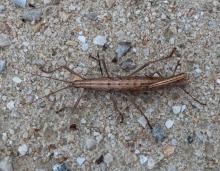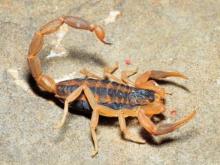Land Invertebrates
Media

Species Types
Scientific Name
More than 900 species in North America north of Mexico
Description
Millipedes, which have two pairs of legs per body segment, are harmless detritus-eaters, move slowly, and curl up defensively when harassed.
Media

Species Types
Scientific Name
Diapheromera femorata, Megaphasma denticrus, and others
Description
Walkingsticks are long, slender insects that are perfectly camouflaged to look like brown or green twigs. Most species are tropical, but some types are found in Missouri.
Media

Species Types
Scientific Name
Anisomorpha ferruginea
Description
Be careful when approaching northern two-striped walkingsticks: They can squirt an acrid fluid at you. Musk mare, devil’s riding horse, and prairie alligator are all names for this remarkable stick insect.
Media

Species Types
Scientific Name
Anoplophora glabripennis
Description
An unwanted arrival from Asia that's now living in parts of the United States, the Asian longhorned beetle could destroy millions of acres of American hardwoods. Report any sightings immediately.
Media

Species Types
Scientific Name
Loxosceles reclusa
Description
The brown recluse is a spider whose venomous bite may be medically significant to humans, though a bite is almost never fatal. Brown recluses are most commonly encountered in houses, where they occupy little-used drawers, closets, and other small hiding spaces.
Media

Species Types
Scientific Name
Centruroides vittatus
Description
Striped bark scorpions are pale yellowish brown, usually with two lengthwise dark stripes on the abdomen. It is the only species of scorpion in Missouri. It occurs in glades and other dry, warm, rocky areas, and sometimes in buildings and shelters and under piles of wood, brush, or garbage.
Media

Species Types
Scientific Name
8 tribes, with about 23 genera, in North America north of Mexico
Description
Millipedes in family Xystodesmidae often have bright colors that serve as a warning to potential predators that they may secrete foul or toxic substances.
Media

Species Types
Scientific Name
Microcentrum retinerve
Description
The lesser angle-winged katydid is one of our common species of so-called false katydids. Its song is a single 3-5-pulsed rattle, with about a second of silence between each rattle.
Media

Species Types
Scientific Name
Stagomantis carolina, Mantis religiosa, and Tenodera sinensis
Description
Most people recognize mantids, or mantises, when they see them, but it takes more practice to distinguish among the different species of these efficient insect predators.
Media

Species Types
Scientific Name
About 28 species in North America
Description
Horntails look a lot like wasps but have a taillike spine that projects from the tip of the abdomen. Their cylindrical bodies also lack the narrow waist so common in wasps.
See Also



Media

Species Types
Scientific Name
Cisseps fulvicollis
Description
The yellow-collared scape moth is more often “orange-collared.” And whether you think it looks more like a firefly or a wasp, it’s still a moth!
Media

Species Types
Scientific Name
Nearly 150 species in North America north of Mexico
Description
Slim, delicate plume moths are instantly recognizable by their T-shaped silhouette, long legs, and muted shades of tan and brown. It can be hard to separate the various species.
Media

Species Types
Scientific Name
Pyrrharctia isabella
Description
Not many people know the adult Isabella tiger moth when they see one, but we’re all acquainted with its caterpillar, the woolly worm, or woolly bear.
About Land Invertebrates in Missouri
Invertebrates are animals without backbones, including earthworms, slugs, snails, and arthropods. Arthropods—invertebrates with “jointed legs” — are a group of invertebrates that includes crayfish, shrimp, millipedes, centipedes, mites, spiders, and insects. There may be as many as 10 million species of insects alive on earth today, and they probably constitute more than 90 percent all animal species.





















